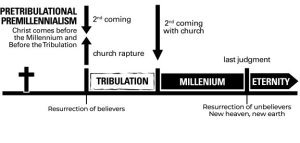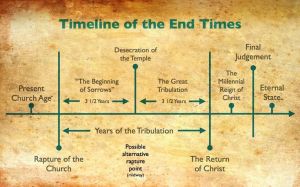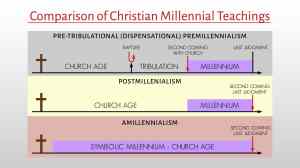![]() In discussing these beliefs, we must remember that each has some biblical validity and we shouldn’t fight or argue about which belief is best. The most important truth to remember is that Jesus is returning in power to take His church (believers) with Him to heaven for all eternity! Our part is to be watchful and ready. Are you ready for Jesus to return?
In discussing these beliefs, we must remember that each has some biblical validity and we shouldn’t fight or argue about which belief is best. The most important truth to remember is that Jesus is returning in power to take His church (believers) with Him to heaven for all eternity! Our part is to be watchful and ready. Are you ready for Jesus to return?
The return of Jesus and end times is known in theological terms as Eschatology, the study of last things.
In eschatology, it is important to remember that almost all Christians agree on these three things:
- There is coming a time of Great Tribulation such as the world has never seen.
- After (or for some, before) the Great Tribulation, Christ will establish His millennial kingdom on earth.
- There will be Rapture; when Jesus returns to take His bride/church to be with him in Heaven, John 14:1-3. When our earthly bodies are transformed or resurrected into heavenly bodies 1 Corinthians 15:51-52; when Jesus returns with a trumpet of the archangel and all believers are caught up in the air to meet the Lord in the air to be with him for all eternity! 1 Thessalonians 4:16-17).
One question that causes differing opinions is, “when does the Rapture occur in relation to the Tribulation and the Day of the Lord?”
 Through the years three main convictions have emerged concerning the timing of the Rapture: Pre-tribulation view (the belief that the Rapture will occur before the Tribulation begins), Mid-tribulation view (the belief that the Rapture will occur at the midpoint of the Tribulation), and Post-tribulation view (the belief that the Rapture will occur at the end of the Tribulation). This post deals mainly with the pre-tribulation view, which I adhere to.
Through the years three main convictions have emerged concerning the timing of the Rapture: Pre-tribulation view (the belief that the Rapture will occur before the Tribulation begins), Mid-tribulation view (the belief that the Rapture will occur at the midpoint of the Tribulation), and Post-tribulation view (the belief that the Rapture will occur at the end of the Tribulation). This post deals mainly with the pre-tribulation view, which I adhere to.
Belief in Pretribulation Rapture teaches that the Rapture occurs before the Tribulation starts. At that time, the church will meet Christ in the air, and then sometime after that the Antichrist is revealed and the Tribulation begins. In other words, the Rapture and Christ’s Second Coming (to set up His kingdom) are separated by at least seven years. According to this view, the church does not experience any of the Tribulation.
Scripturally, the Pre-tribulation view has much to commend it. For example, the church is not appointed to wrath (1 Thessalonians 1:9-10, 5:9), and believers will not be overtaken by the Day of the Lord (1 Thessalonians 5:1-9). The church of Philadelphia was promised to be kept from “the hour of trial that is going to come upon the whole world” (Revelation 3:10). Note that the promise is not preservation through the trial but deliverance from the hour, that is, from the time period of the trial.
 The Pretribulation view also finds support in what is not found in Scripture. The word “church” appears nineteen times in the first three chapters of Revelation, but, significantly, the word is not used again until chapter 22. In other words, in the entire lengthy description of the Tribulation in Revelation, the word church is noticeably absent. In fact, the Bible never uses the word “church” in a passage relating to the Tribulation.
The Pretribulation view also finds support in what is not found in Scripture. The word “church” appears nineteen times in the first three chapters of Revelation, but, significantly, the word is not used again until chapter 22. In other words, in the entire lengthy description of the Tribulation in Revelation, the word church is noticeably absent. In fact, the Bible never uses the word “church” in a passage relating to the Tribulation.
 The Pretribulation view is the only theory which clearly maintains the distinction between Israel and the church and God’s separate plans for each. The seventy “sevens” of Daniel 9:24 are decreed upon Daniel’s people (the Jews) and Daniel’s holy city (Jerusalem). This prophecy makes it plain that the seventieth week (the Tribulation) is a time of purging and restoration for Israel and Jerusalem, not for the church.
The Pretribulation view is the only theory which clearly maintains the distinction between Israel and the church and God’s separate plans for each. The seventy “sevens” of Daniel 9:24 are decreed upon Daniel’s people (the Jews) and Daniel’s holy city (Jerusalem). This prophecy makes it plain that the seventieth week (the Tribulation) is a time of purging and restoration for Israel and Jerusalem, not for the church.
Also, the Pretribulation view has historical support. From John 21:22-23, it would seem that the early church viewed Christ’s return as imminent, that He could return at any moment. Otherwise, the rumor would not have persisted that Jesus would return within John’s lifetime. Imminence, which is incompatible with the other two Rapture theories, is a key tenet of the Pretribulation view.
And the Pretribulation view seems to be the most in keeping with God’s character and His desire to deliver the righteous from the judgment of the world. Biblical examples of God’s salvation include Noah, who was delivered from the worldwide flood; Lot, who was delivered from Sodom; and Rahab, who was delivered from Jericho (2 Peter 2:6-9).
One perceived weakness of Pretribulation View is that Pretribulation view splits the return of Jesus Christ into two “phases”—the Rapture and the Day of the Lord—whereas some argue that the Bible does not clearly delineate phases.
Another difficulty facing the Pretribulation view is the fact that there will obviously be saints in the Tribulation (Revelation 13:7, 20:9). The Pre-tribulation people answer this by distinguishing the saints of the Tribulation from the church of the New Testament. Believers alive at the Rapture will be removed before the Tribulation, but there will be those who will come to Christ during the Tribulation.
Some point to Jesus’ statement in John 6:40 as posing a difficulty to Pre-tribulation view: “My Father’s will is that everyone who looks to the Son and believes in him shall have eternal life, and I will raise them up at the last day.” Jesus promises believers a resurrection “at the last day,” but the Pre-tribulation view has believers being raised at the rapture, at least seven years before the Christ’s second coming. The answer to this involves a general use of the word day—the end times, called “the last day,” will span the entire time from the Rapture to the Day of the Lord coming. Also, the rapture will mark the end of the church age and thus is “the last day” of this dispensation.
And a final weakness of the Pretribulation view is shared by the other two views namely, the Bible does not give an explicit time line concerning future events. Scripture does not expressly teach one view over another, and that is why we have diversity of opinion concerning the end times and some variety on how the related prophecies should be harmonized.
Now let’s discuss the Millenium views:
The millennial kingdom is called by many names in Scripture. In Matthew 19:28 Jesus calls it “the regeneration.” Acts 3:19 describes the kingdom as “times of refreshing,” while verse 21 of that chapter calls it “the period of restoration of all things.” The apostle Paul refers to it in Ephesians 1:10 as “an administration suitable to the fullness of the times.”
The Bible’s teaching on the kingdom is not confined to the New Testament. The kingdom is an important theme throughout Scripture; it is the goal toward which all of redemptive history progresses. In the words of John Bright, “The Bible is one book. Had we to give that book a title, we might with justice call it ‘The Book of the Coming Kingdom of God'” (The Kingdom of God [Nashville: Abingdon, 1953], 197; italics in original). Among the many Old Testament passages that speak of the earthly kingdom are Deuteronomy 30:1-5; 2 Samuel 7:12-16; Psalm 2:6-12; Isaiah 2:2-4; 11:1-10; 12:1-6; 24:23; 32:15-20; 35:1-2; 60:10-18; 65:20-22; Jeremiah 3:14-18; 23:5-6; 30:3; 31:35-40; 33:14-18; Ezekiel 34:23-24; 36:16-38; 37:15-28; Daniel 2:44-45; Hosea 3:4-5; Joel 3:18-21; Amos 9:11-15; Micah 4:1-8; Zephaniah 3:14-20; and Zechariah 14:9-11.
God’s kingdom may be broadly defined as the sphere in which He reigns. In its universal, eternal sense, God’s kingdom encompasses everything that exists, because God is the sovereign ruler over all of His creation. David declared that truth in Psalm 103:19: “The Lord has established His throne in the heavens, and His sovereignty rules over all.” Historically, God has mediated His rule on earth through His people, first through Adam and Eve, then Abel, Seth, Enoch, Noah, Abraham, Isaac, Jacob, Joseph, Moses, Joshua, the judges of Israel (including Samuel), and the kings of Israel and Judah. In the present era, God mediates His rule politically through human governments (Rom. 13:1-7) and spiritually through the church (Acts 20:25; Rom. 14:17; Col. 1:13). In the millennial kingdom, the political and religious elements of God’s temporal, earthly rule will be reunited in the Person of the Lord Jesus Christ.
*Taking the text of Revelation 20 (and the numerous other biblical passages that speak of the earthly kingdom) at face value leads to a “Premillennial” view of eschatology. That is, Christ will return, and then establish a literal kingdom on earth, which will last for a thousand years.
 There are two other major views of the Millennium in addition to a Premillennial view: Postmillennial and Amillennial
There are two other major views of the Millennium in addition to a Premillennial view: Postmillennial and Amillennial
- A Postmillennial view is in some ways the opposite of Premillennial view. A Premillennial believes that Christ will return before the Millennium; A Postmillennial teaches that He will return at the end of the Millennium. Premillennialism teaches that the period immediately before Christ’s return will be the worst in human history; postmillennialism teaches that before His return will come the best period in history, so that Christ will return at the end of a long golden age of peace and harmony. (Most Postmillennial believers deny that the Millennium will last for one thousand actual years; they arbitrarily view that number as symbolic of a long period of time.) “The millennium to which the Postmillennial looks forward is thus a golden age of prosperity during this present dispensation, that is, during the Church Age” (Loraine Boettner, “Postmillennialism,” in The Meaning of the Millennium: Four Views Robert G. Clouse, ed. [Downers Grove, Ill: InterVarsity, 1977], 117). That golden age, according to Postmillennial, will result from the spread of the gospel throughout the world and the conversion of a majority of the human race to Christianity. Thus “Christ will return to a truly Christianized world” (Boettner, “Postmillennialism,” 118). The millennial kingdom, according to a Postmillennial, will be established by the church, not by the personal intervention of Jesus Christ. Nor will Christ reign personally on earth during the Millennium, but rather through His church.
In keeping with the generally optimistic views of those eras, Postmillennial beliefs flourished in the eighteenth and nineteenth centuries. The impact of the Enlightenment, the Industrial Revolution, the rapid pace of scientific discovery, and Darwin’s theory of evolution convinced many that society was progressing inevitably toward a utopia. That optimistic view was in harmony with postmillennialism, which also teaches that the world is going to get better and better (though by different means). But the numbing horror of the First World War, the moral decadence of the Roaring Twenties, the hard times of the Great Depression, the madness of the Nazi’s slaughter of the Jews, and the worldwide catastrophe of the Second World War brought an end to the naive optimism that had prevailed before World War I. Postmillennialism accordingly also declined in popularity. In recent years, however, there has been a resurgence of postmillennialism in such movements as Liberation Theology, Kingdom Theology, and Theonomy.
2. The name “Amillennial” is somewhat misleading, since it implies that amillennialists do not believe in a millennium. While it is true that they reject the concept of an earthly millennium, and especially one that is actually a Millennium (one thousand years in duration), Amillennialists do believe in a kingdom. They believe the Old Testament prophecies of the Messiah’s kingdom are being fulfilled now, either by the saints reigning with Christ in heaven, or (spiritually, not literally) by the church on earth. (Amillennialists would also apply some of those Old Testament prophecies to the eternal state.) Far from disbelieving in the Millennium, Amillennialists believe we are in it now: “As far as the thousand years of Revelation 20 are concerned, we are in the millennium now” (Anthony A. Hoekema, “Amillennialism,” in The Meaning of the Millennium: Four Views, ed. Clouse, 181).
John MacArthur states, “There is absolutely no exegetical reason or source for this conclusion and no warrant for abandoning the historical, grammatical hermeneutic when interpreting prophecy. Such is purely an arbitrary act on the part of the interpreter, based on his presuppositions. Furthermore, there is no reason to deny a literal one thousand years as the duration of the kingdom of Christ on earth.
It is highly doubtful that any symbolic number would be repeated six times in a text, as “one thousand” is here.
For the first century and a half after the close of the New Testament era, the church was largely Premillennial. Among the church fathers of that period who believed in a literal thousand-year earthly Millennium were Papias (a disciple of the apostle John), Irenaeus, Justin Martyr, Tertullian, and the author of the Epistle of Barnabas. That premillennial consensus was challenged by the members of the Alexandrian school (most notably Origen), who advocated an allegorical approach to interpreting Scripture. The famous church historian Eusebius also rejected a literal, earthly Millennium, as did the noted Bible scholar Jerome. But it was the influence of Augustine, the greatest theologian of the early church, that ensured that amillennialism would dominate the church for centuries. Amillennialism was the view of the Reformers, and today most scholars in the Reformed tradition are amillennialists.
At the heart of the debate over millennial views is the issue of hermeneutics. All sides in the debate agree that interpreting Old Testament prophecy literally leads naturally to premillennialism. Amillennialist Floyd E. Hamilton candidly acknowledges that truth: “Now we must frankly admit that a literal interpretation of the Old Testament prophecies gives us just such a picture of an earthly reign of the Messiah as the premillennialist pictures” (The Basis of Millennial Faith [Grand Rapids: Eerdmans, 1942], 38). Postmillennialist Loraine Boettner agrees with Hamilton’s assessment: “It is generally agreed that if the prophecies are taken literally, they do foretell a restoration of the nation of Israel in the land of Palestine with the Jews having a prominent place in that kingdom and ruling over the other nations” (“A Postmillennial Response [to Dispensational Premillennialism],” in The Meaning of the Millennium: Four Views, ed. Clouse, 95).
In light of the above admissions, the question that naturally arises is “Why not take the Old Testament prophecies of the Millennium literally?” Those who reject a literal interpretation argue that the New Testament appears to interpret some Old Testament prophecies nonliterally. But in most cases, the New Testament is not interpreting those prophecies, but merely applying principles found in them. In fact, scores of Old Testament prophecies relating to Christ’s first coming were literally fulfilled.
There are several compelling reasons for interpreting Old Testament prophecies literally.
- First, if the literal sense of a passage is rejected, who is to determine what the nonliteral or spiritual sense is, since the normal rules of interpretation do not apply? Walter C. Kaiser, Jr., poses the dilemma:
Who or what will arbitrate among the various [nonliteral] meanings suggested and decide which are to be accepted as authoritative and which are spurious? Short of saying that every person’s fancy is his or her own rule, there does not appear to be any final court of appeal… There simply are no justifiable criteria for setting boundaries once the interpreter departs from the normal usage of language. (Back Toward the Future [Grand Rapids: Baker, 1989], 129-30)
2. Second, adopting a nonliteral view of the Old Testament kingdom prophecies raises some disturbing questions: What did those prophecies mean to those to whom they were addressed? If prophecies seemingly addressed to Israel really apply to the church (which did not exist at that time), did God give revelation that failed to reveal? And if those prophecies were meant to apply symbolically to the church, why were they addressed to Israel? What meaning could such prophecies have in their historical settings? Ironically, many who spiritualize Old Testament prophecies reject the futurist interpretation of Revelation because it allegedly robs the book of its meaning for those to whom it was written. Yet they do the very same thing with the Old Testament kingdom prophecies.
3. Third, spiritualizing those prophecies leads to some glaring inconsistencies. It is inconsistent to argue that the cursings they pronounce apply literally to Israel, while the blessings they promise apply symbolically and spiritually to the church. An example of inconsistency in the spiritualizing method of interpreting prophecy comes from the angel Gabriel’s words to Mary in Luke 1:31-33: “And behold, you will conceive in your womb and bear a son, and you shall name Him Jesus. He will be great and will be called the Son of the Most High; and the Lord God will give Him the throne of His father David; and He will reign over the house of Jacob forever, and His kingdom will have no end.” If, as all conservative scholars agree, Jesus was literally conceived in Mary’s womb, literally named “Jesus,” literally became great, was literally “the Son of the Most High,” will He not also literally reign on David’s throne over Israel? Can the same passage be interpreted both literally and nonliterally? Further, both Amillennialists and Postmillennialists interpret some prophetic events literally, such as Christ’s second coming, the Great White Throne judgment, and the new heavens and the new earth. Why not interpret the millennial kingdom literally?
Again we shouldn’t fight or argue about which belief is best. The most important truth to remember is that Jesus is returning in power to take His church (believers) with Him to heaven for all eternity! Our part is to be watchful and ready. Are you ready for Jesus to return?
Darrell
Watch Messages: YouTube-Upwards Church